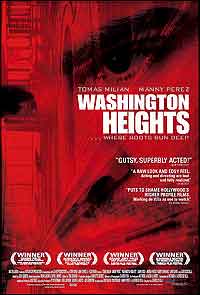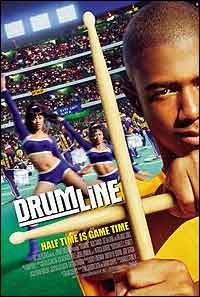Shake,
Rattle and Roll:
The Reel Sound of Foley
By
Jennifer Chen
 In
the movie Washington
Heights, a stabbing scene was accentuated by the sound
of a knife cutting into flesh. But the sound wasn't real. It was
Joe Diehl, plunging a chisel into a honeydew melon. In
the movie Washington
Heights, a stabbing scene was accentuated by the sound
of a knife cutting into flesh. But the sound wasn't real. It was
Joe Diehl, plunging a chisel into a honeydew melon.
Diehl was
working his Foley magic. Foley is the recreation of sound in
synchronization with a picture on screen. It can be anything from
the sound of footsteps to china and silver clinking on a dining
table. Foley is about synchronization, Diehl said. "You're creating
that illusion in sync with the picture, which is really just still
pictures moving fast."
Diehl is
a Foley artist working as an independent contractor under Goldcrest
Post Productions. Despite the technological boom of the film and
sound production industry, the manmade sounds generated through
Foley art have survived. And the technique is here to stay, Diehl
said.
Jack Foley
invented Foley art in the 1950s by adding sound effects to film
for the first time. In Foley's days, and before the advent of computers,
Foley artists worked directly with the 10 pound film reels. Now,
their work is digitally recorded.
Diehl said
there are three main categories of sounds that Foley
artists create in their post-production studios.
- THE FIRST
IS FOOTSTEPS, which Diehl recreates with the help of his "Foley
floor." Diehl's "Foley floor" has three different surfaces: cement,
gravel, and sand. Each surface is about a yard long. To create
the sound called for, he walks on the surface that best matches
the scene in the movie.
- THE SECOND
IS THE MOVES that accompany footsteps -- like the swishing
of a skirt or the creak of a swinging arm clad in leather.
- THE
THIRD IS THE OTHER SOUNDS that might be called for in a movie.
Diehl calls these sounds "specifics." The stabbing sound in Washington
Heights, which premiered at the TriBeCa Film Festival in May,
falls in this category. In the same movie, the sound of a hammock
swinging is really Diehl twisting a leather jacket. "When you're
getting the props," Diehl said, "it's like a scavenger hunt."
Among
the props in his West Village studio in Manhattan he has an assortment
of beer bottles, bells, coins, and a backgammon set.
Diehl fell
into Foley art after he had been producing music for films and
television. One day he watched a director substitute a stapler for
a clipping sound. "That was a real insight into thinking," Diehl
said. He began to add in sounds at directors' requests and, over
the course of 25 years, he developed his technique.
Likewise,
Nancy Cabrera,
a Foley artist at Sound One,
a New York post-production company, also fell into the profession
by accident. The former dancer was looking for a career change and
saw an advertisement for a Foley artist in the paper. "I didn't
even know what Foley was," she said. Cabrera regularly walks miles
in many different shoes. The 12-year veteran has worked on movies
like A Beautiful Mind and television shows like Ed.
 Cabrera's
current project is Drumline,
a Fox feature film about a marching band. She said the Foley work
could take longer than the eight days that were budgeted, since
the film involves a lot of footsteps that she has to recreate by
herself. Cabrera recently stood at the back of Sound One's cranberry-colored
15- by 20-foot Foley studio, facing a large screen. She had on a
pair of shoes, which she had taken from a shelf stacked full of
several dozen different types of footwear. She was clad in black
pajama pants and a black T-shirt over a long-sleeved cotton shirt,
to minimize the sound of the movement of her clothes. Cabrera's
current project is Drumline,
a Fox feature film about a marching band. She said the Foley work
could take longer than the eight days that were budgeted, since
the film involves a lot of footsteps that she has to recreate by
herself. Cabrera recently stood at the back of Sound One's cranberry-colored
15- by 20-foot Foley studio, facing a large screen. She had on a
pair of shoes, which she had taken from a shelf stacked full of
several dozen different types of footwear. She was clad in black
pajama pants and a black T-shirt over a long-sleeved cotton shirt,
to minimize the sound of the movement of her clothes.
She watched
the film for her cue, and the red Record sign lit up underneath.
Cabrera started to step deliberately in sync with Devon, one of
the film's characters. A microphone pointed at her feet amplified
her footfalls, so that the technicians sitting in the booth behind
her could hear. During the course of the next two hours, Cabrera
swished a nylon jacket, rustled money, rattled ice in a glass, slapped
her own hand, and walked in four different pairs of shoes. She even
had to fill in the sound for the blurry guy in the background as
he sat down at a table.
Ryan
Collison, a Foley engineer, and a freelance Foley
editor, William Sweeney,
sat in an enclosed booth behind Cabrera. While Collison operated
the computer and sound panel, Sweeney directed her through each
sound and decided if each sound was good enough. Sometimes the sound
was too big, too poppy, too dull, too sharp, or too high-pitched.
Each sound usually took more than one try.
The amount
of Foley in a film depends on the budget, Sweeney said. The
lower the budget, the less Foley used. Computers actually help the
process, Collison said. "They make it a lot easier and faster. You
get a better visual sense as to where the sounds are," he said.
A sound library
is stored on Diehl's computer with hundreds of sounds stored
on it, for when he can't go out and get the sound. If he needed
a 9-mm. Beretta gunshot, for example, he would go in and choose
one of six or seven different gun shot sounds.
Diehl often
uses substitutions, like yards of recording tape that stand
in for rustling leaves. "You don't have to be the real thing as
long as it sounds like it, feels like it when you see it. A lot
of people wouldn't know the difference." But he added, "For the
extent that you make it real, you do."
Both Diehl
and the Foley team at Sound One agree that Foley will never
become extinct. "There are certain things that are too specific
to pull out of a library," Collison said. "You can do whatever kind
of shoe you want here." Foley
gets the job done with a little more ease and finesse, Diehl said.
"Thank God for Jack Foley."
Original URL: http://www.jrn.columbia.edu/studentwork/cns/2002-06-10/syndication/jchen-foley.txt
|